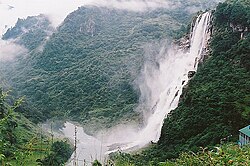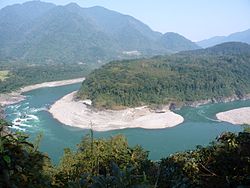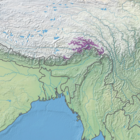Geography of Arunachal Pradesh
This article needs additional citations for verification. (May 2015) |
Template:Infobox place geography

Arunachal Pradesh is primarily a hilly tract nestled in the foothills of the Himalayas in northeast India. It is the largest state in northeast India spread over an area of 83,743 km2 (32,333 sq mi).[1] 98% of the geographical area is land out of which 80% is forest cover;[2] 2% is water.[3] River systems in the region, including those from the higher Himalayas and Patkoi and Arakan Ranges, eventually drain into the Brahmaputra River.[4]
Arunachal shares international borders of 160 km (99 mi) long with Bhutan in the west while a 1,030 km (640 mi) long border separates the state from China in the north. A 440 km (270 mi) long border exists between Arunachal Pradesh and Burma in the east. It borders the states of Assam in the south and Nagaland in the east and southeast. Arunachal is called the "orchid state of India"[5][6] and "dawn-lit mountain/Land of Dawn-Lit Mountains".[7]
Topography[edit | edit source]
Arunachal Pradesh is encompassed by the Shivalik ranges.[4] From the snow-capped mountains of the eastern Himalayas to sparsely populated mountainous areas in the extreme north-eastern part of the state, these lofty slopes form an indelible part of the area in Arunachal Pradesh.
| Passes and mountains in Arunachal, or on or close to its borders.[lower-alpha 1] |
Relief[edit | edit source]
The land is mostly mountainous with the Himalayan ranges running north south. Kangto, Nyegi Kangsang, the Gorichen group of mountains are some of the highest peaks in this region of the Himalayas.[10]
| Mountain name | Peak | Coordinates | Refs |
|---|---|---|---|
| Kangto # | 7,089 metres (23,258 ft) | 27°51′54″N 92°31′55″E / 27.865°N 92.532°E | [11][12] |
| Nyegyi Kansang # | 7,047 metres (23,120 ft) | 27°56′10″N 92°39′58″E / 27.936°N 92.666°E | [13] |
| Chumo # | 6,890 metres (22,600 ft) | 27°54′32″N 92°37′30″E / 27.909°N 92.625°E | [14] |
| Tapka Shiri # ** | 6,565 metres (21,539 ft) | 28°10′34″N 92°46′01″E / 28.176°N 92.767°E | [11][15] |
| Gori Chen | 6,530 metres (21,420 ft) | 27°47′42″N 92°23′13″E / 27.795°N 92.387°E | [16][17] |
| Shalundi | 4,810 metres (15,780 ft) | [11] | |
| Dapha Bum | 4,578 metres (15,020 ft) | 27°39′36″N 96°41′56″E / 27.660°N 96.699°E | [11][18] |
| Komdi | 4,185 metres (13,730 ft) | [11] | |
| Vorjing | 3,989 metres (13,087 ft) | [11] | |
| Ladu | 3,041 metres (9,977 ft) | [11] | |
| # Mountain (as compared to the peak) is located in both India and China
** This is not Dakpa Sheri, 5,735 metres (18,816 ft)[15] | |||

The area in Arunachal Pradesh is divided into twenty five districts. Parts of the Lohit district, Changlang and Tirap district are covered by the Patkai hills. The Himalayan ranges that extend up to the eastern Arunachal separate it from Tibet. The ranges extend toward Nagaland, and form a boundary between India and Burma in Changlang and Tirap district, acting as a natural barrier called Patkai Bum Hills. They are low mountains compared to the Greater Himalayas.[19] Namcha Barwa range extends into India.
Major hills found in this region include:
- Aka Hills
- Daphla Hills
- Miri Hills
- Abor Hills
- Mishmi Hills
- Patkai Hills
Drainage and river systems[edit | edit source]
Water/wetland cover is 154,609 hectares (1,546.09 km2) or 1.91% of the total area.[3] Out of this, 86% of wetlands are rivers.[3] Lohit district and Dibang Valley district have the highest number of wetlands in the state.[3]
The major river systems are (from west to east clockwise):[20][21]
All of these are fed by snow from the Himalayas and numerous rivers and rivulets and eventually flow into Siang/Brahmaputra. Abrasion by the rivers which flow through the mountains has created a broad valley, which is a major feature of the geography of the state.
Other rivers include Tawang Chu, Dikrong, Ranga, Kamala/Kamla, Kamplang, Siyum, Dihing/ Noadihing and Tirap.[22]
- Four major river basins of the state
Biodiversity[edit | edit source]
Eco-regions and forest types[edit | edit source]
Arunachal consists of a number of eco-regions. At the lowest elevations, at Arunachal Pradesh's border with Assam, are the Brahmaputra Valley semi-evergreen forests. Much of the state, including the Himalayan foothills and the Patkai hills, are home to Eastern Himalayan broadleaf forests. Towards the northern border with Tibet, with increasing elevation, come a mixture of Eastern and Northeastern Himalayan subalpine conifer forests followed by Eastern Himalayan alpine shrub and meadows.
- Ecoregions
Climatically, the forests can be categorised as tropical and sub-tropical forests, temperate forest, pine forests and subalpine forest, alpine and secondary forests.[23][24] At the lowest elevations, densely forested areas are seen with the trees ranging from semi-evergreen to broadleaf and semi-alpine forests. Alpine shrubs and meadows follow, ultimately leading to ice-clad peaks.
The Forest Research Institute of India's India State of Forest Report 2019 lists area under different forest types in the state.[25] The major forest types as a percentage of the forest cover area are:
- East Himalayan Sub-Tropical Wet Hill Forest = 24.35%[25]
- East Himalayan Wet Temperate Forest = 22.92%[25]
- East Himalayan Sub-Alpine Birch/Fir Forest = 13.46%[25]
- Alpine Pastures = 6.73%[25]
- Sub-Himalayan Light Alluvial Semi-Evergreen Forest = 6.60%[25]
- Others = Remaining[25]
Forest cover varies from 54% in Tawang district to 92% in Papum Pare district.[26] There are 110 species of trees.[25]
Protected areas include the Dihang-Dibang Biosphere Reserve, Namdapha National Park, Mouling National Park, and 11 wildlife sanctuaries and reserves including elephant reserves, tiger reserves and an orchid sanctuary,[lower-alpha 2] covering about 12% of the geographical area of the state.[27]
Flora and fauna[edit | edit source]
Flora and fauna in the state includes over 4000 species of flowering plants,[28] 600 bird species, 200 fish species,[29] 42 amphibian species, 85 terrestrial mammals and a wide number of insects, butterflies and reptiles.[23][30] Orchids, fern, bamboo, cane, rhododendrons, oak, hedychiums, and various medicinal plants form a diverse range of the state's green cover. Among the crops grown here are rice, maize, millet, wheat, pulses, sugarcane, ginger, and oilseeds. Arunachal is also ideal for horticulture and fruit orchards. Its major industries are rice mills, fruit preservation and processing units, and handloom handicrafts Apart from them, the forests of Arunachal are also home to a large number of people belonging to the different tribes. These tribal people, aloof from urbanization, dwell in these forests where the various forest-based products form a part of their livelihood.
The Strobilanthus flower at the Namdapha National Park
Hornbills at the Namdapha National Park
Climatic conditions[edit | edit source]
Due to the topographical diversity, the climate in Arunachal Pradesh ranges from sub-tropical to temperate depending upon the altitude. The regions in the lower belts of the state experience hot and humid climates, with a maximum temperature in the foothills reaching up to 40 °C (during the summer). The average temperature in this region in winter ranges from 15° to 21 °C while that during the monsoon season remains between 22° and 30 °C.[31][32][33][34]
The areas around the middle belt of Arunachal Pradesh are relatively cooler. The middle belt in Arunachal Pradesh experiences micro thermal climate. Moreover, Arunachal Pradesh possesses an alpine climate in the higher altitudes of the state. The higher regions of Arunachal Pradesh witness snowfall during winter. The snowfall draws large number of tourists to the state from all across the world.
Arunachal Pradesh experiences heavy rainfall during May to September. The average rainfall recorded in Arunachal Pradesh is 300 centimeters, varying between 80 centimeters and 450 centimeters.[citation needed]
See also[edit | edit source]
References[edit | edit source]
- Notes
- ↑ Gori Chen, Kangto, Bum La, Yonggyap La, Nyegyi Kansang, Diphu Pass, Sela Pass, Dzo La, Chubumbu La, Gyoa La, Lo La, Shagam La, Tama La, Tapgyu La, Chupung La, Kashong La, Andra La, Zhabu La, Kaya La, Pangsau Pass, Kumjawng Pass, Chaukan Pass, Hpungan Pass, Dafla Range High Point, Dapha Bum, Pakhain Range High Point[8][9]
- ↑ D'Ering Memorial Wildlife Sanctuary, Dibang Wildlife Sanctuary, Eaglenest Wildlife Sanctuary, Itanagar Wildlife Sanctuary, Kameng Elephant Reserve, Kamlang Wildlife Sanctuary, Mehao Wildlife Sanctuary, Pakke Tiger Reserve, Talle Valley Wildlife Sanctuary, Dibang Wildlife Sanctuary and Sessa Orchid Sanctuary
- References
- ↑ "Arunachal Pradesh: Physiography, At a glance". gbpihedenvis.nic.in. Hosted by: G.B. Pant National Institute of Himalayan Environment and Sustainable Development. Sponsored by: Ministry of Environment, Forest & Climate Change, Govt of India. ENVIS Centre on Himalayan Ecology. Retrieved 23 June 2021.
{{cite web}}: CS1 maint: others (link) CS1 maint: url-status (link) - ↑ ISFR Vol 1, Forest Survey of India (2019), pg. 24.
- ↑ 3.0 3.1 3.2 3.3 Space Applications Centre, ISRO (2009), pg. 19.
- ↑ 4.0 4.1 Sharma & Shukla 1992, p. 6-7.
- ↑ "4 Reasons Why Arunachal Pradesh is a Natural Wonderland". Outlook India Traveller. 26 June 2018. Retrieved 23 June 2021.
We may as well call Arunachal a flowery paradise. Arunachal is also called Orchid State of India
{{cite web}}: CS1 maint: url-status (link) - ↑ "Launching IUCN Red-listing Process for Orchids in Arunachal Pradesh, India". IUCN. 3 December 2020. Retrieved 23 June 2021.
The biodiversity rich North-East States in India are endowed with over 870 species in 159 genera constituting over 73% of the total Orchid species reported from India. Arunachal Pradesh has the highest number of orchid species (around 622 species) reported from the state. Arunachal Pradesh has also been termed as 'Orchid Paradise of India' because of the maximum concentration of orchid species (about 40% of the country) in the State.
{{cite web}}: CS1 maint: url-status (link) - ↑ Bolingbroke-Kent, Antonia (15 June 2017). Land of the Dawn-lit Mountains. Simon and Schuster. ISBN 978-1-4711-5657-1.
- ↑ OpenStreetMap contributors (4 July 2021). "Arunachal Pradesh" (Map). OpenStreetMap. Retrieved 4 July 2021.
{{cite map}}:|author=has generic name (help) - ↑
- U.S. Army Map Service (1955), NG 46-2 Towang. Tile of the Map India and Pakistan 1:250,000. Series U502, retrieved 6 July 2021
- U.S. Army Map Service (1955), NH 46-15 Kyimdong Dzong. Tile of the Map India and Pakistan 1:250,000. Series U502, retrieved 5 July 2021
- U.S. Army Map Service (1954), NH 46-12 Namcha Barwa. Tile of the Map China 1:250,000. Series L500, retrieved 5 July 2021
- U.S. Army Map Service (1954), NH 47-9 Su-Tun. Tile of the Map China 1:250,000. Series L500, retrieved 5 July 2021
- U.S. Army Map Service (1954), NH 47-13 Li-Ma. Tile of the Map China 1:250,000. Series L500, retrieved 5 July 2021
- U.S. Army Map Service (1955), NG 47-1 Putao. Tile of the Map Burma 1:250,000. Series U542, retrieved 5 July 2021
- U.S. Army Map Service (1955), NG 46-8 Sibsagar. Tile of the Map Burma 1:250,000. Series U542, retrieved 6 July 2021
- ↑ Sharma & Shukla 1992, p. 7.
- ↑ 11.0 11.1 11.2 11.3 11.4 11.5 11.6 Singh 2005, p. 5.
- ↑ "Kangtö". Peakbagger.com. Retrieved 4 July 2021.
{{cite web}}: CS1 maint: url-status (link) - ↑ "Nyegyi Kansang". Peakbagger.com. Retrieved 4 July 2021.
{{cite web}}: CS1 maint: url-status (link) - ↑ "Chumo". Peakbagger.com. Retrieved 4 July 2021.
{{cite web}}: CS1 maint: url-status (link) - ↑ 15.0 15.1 "Takpa Shiri". Peakbagger.com. Retrieved 4 July 2021.
{{cite web}}: CS1 maint: url-status (link) - ↑ U.S. Army Map Service, Corps of Engineers (1955), NG 46-2 Towang. Tile of the Map India and Pakistan 1:250,000. Series U502, U.S. Army Map Service, 1955 (published 1961), retrieved 4 July 2021
- ↑ Bailey, Frederick Marshman (1913), North-East Frontier of India (Arunachal Pradesh) and eastern Tibet, exploration in 1913 by Morshead and Bailey, retrieved 4 July 2021
- ↑ "Dapha Bum". Peakbagger.com. Retrieved 4 July 2021.
{{cite web}}: CS1 maint: url-status (link) - ↑ "Trekking in Arunachal, Trekking Tour in Arunachal Pradesh, Adventure Trekking in Arunachal Pradesh". North-east-india.com. Archived from the original on 30 August 2010. Retrieved 6 October 2010.
- ↑ Singh 2005, p. 6.
- ↑ Sharma & Shukla 1992, p. 8-10.
- ↑ Singh, Abujam & Das 2019, p. 1.
- ↑ 23.0 23.1 Bharali, Sanjeeb; Khan, Mohamed Latif (2011). "Climate change and its impact on biodiversity; some management options for mitigation in Arunachal Pradesh". Current Science. 101 (7): 855–860. ISSN 0011-3891.
- ↑ "Arunachal Pradesh Geography". mapsofindia.com. Retrieved 16 May 2015.
- ↑ 25.0 25.1 25.2 25.3 25.4 25.5 25.6 25.7 ISFR Vol 2, Forest Survey of India (2019), pg. 18.
- ↑ ISFR Vol 2, Forest Survey of India (2019), pg. 15.
- ↑ Rina, Tongam (31 December 2019). "Arunachal registers decline in forest cover for second year in a row". The Arunachal Times. Retrieved 5 July 2021.
{{cite web}}: CS1 maint: url-status (link) - ↑ Zoological Survey of India (2006), pg. 6.
- ↑ Singh, Abujam & Das 2019, p. 2.
- ↑ "Arunachal Pradesh at a Glance". arunachalpradesh.gov.in. Archived from the original on 2 January 2017. Retrieved 16 May 2015.
- ↑ Mizuno & Tenpa 2015, p. 3.
- ↑ "Par Monthly Climate Averages, Arunachal Pradesh, IN". WorldWeatherOnline.com. Retrieved 23 June 2021.
{{cite web}}: CS1 maint: url-status (link) - ↑ "Arunachal Pradesh". Weatherbase. Retrieved 23 June 2021.
{{cite web}}: CS1 maint: url-status (link) - ↑ "Climate Arunachal Pradesh: Temperature, climate graph". en.climate-data.org. Retrieved 23 June 2021.
{{cite web}}: CS1 maint: url-status (link)
Bibliography[edit | edit source]
- Sharma, N.; Shukla, Surya Pal (1992). Geography and Development of Hill Areas: A Case Study of Arunachal Pradesh. Mittal Publications. ISBN 9788170993834 – via Google Books.
- Singh, Ravi S. (2005). Paths of Development in Arunachal Pradesh. Northern Book Centre. ISBN 9788172111830.
- India State of Forest Report 2019 (PDF), vol. 1 (16 ed.), Forest Survey of India. Ministry of Environment, Forest and Climate Change. Government of India., ISBN 9788194101802, archived from the original (PDF) on 8 March 2021
- "11.2 Arunachal Pradesh" (PDF), India State of Forest Report 2019, vol. 2 (16 ed.), Forest Survey of India. Ministry of Environment, Forest and Climate Change. Government of India., ISBN 9788194101802, archived from the original (PDF) on 4 July 2021
- National Wetland Atlas: Arunachal Pradesh (PDF), SAC/RESA/AFEG/NWIA/ATLAS/06/2009, Space Applications Centre (ISRO), Ahmedabad, India, p. 98, archived from the original (PDF) on 28 July 2013. (This is a PDF Size:59.00MB)
{{citation}}: CS1 maint: postscript (link) - Director (Zoological Survey of India, Kolkata), ed. (2006). Fauna of Arunachal Pradesh Part-1 (PDF). ISBN 81-8171-086-X. Archived from the original (PDF) on 20 June 2017.
{{cite book}}:|work=ignored (help) - Mizuno, Kazuharu; Tenpa, Lobsang (2015). Himalayan Nature and Tibetan Buddhist Culture in Arunachal Pradesh, India: A Study of Monpa. Springer. ISBN 9784431554929 – via Google Books.
- Singh, Achom Darshan; Abujam, Santoshkumar; Das, D.N. (2019). Biodiversity of Fishes in Arunachal Himalaya. Academic Press, Elsevier. ISBN 9780128158371.
- Arunachal Pradesh State Action Plan on Climate Change. Consortium: INRM, IIMA, IISc. (PDF), March 2011















